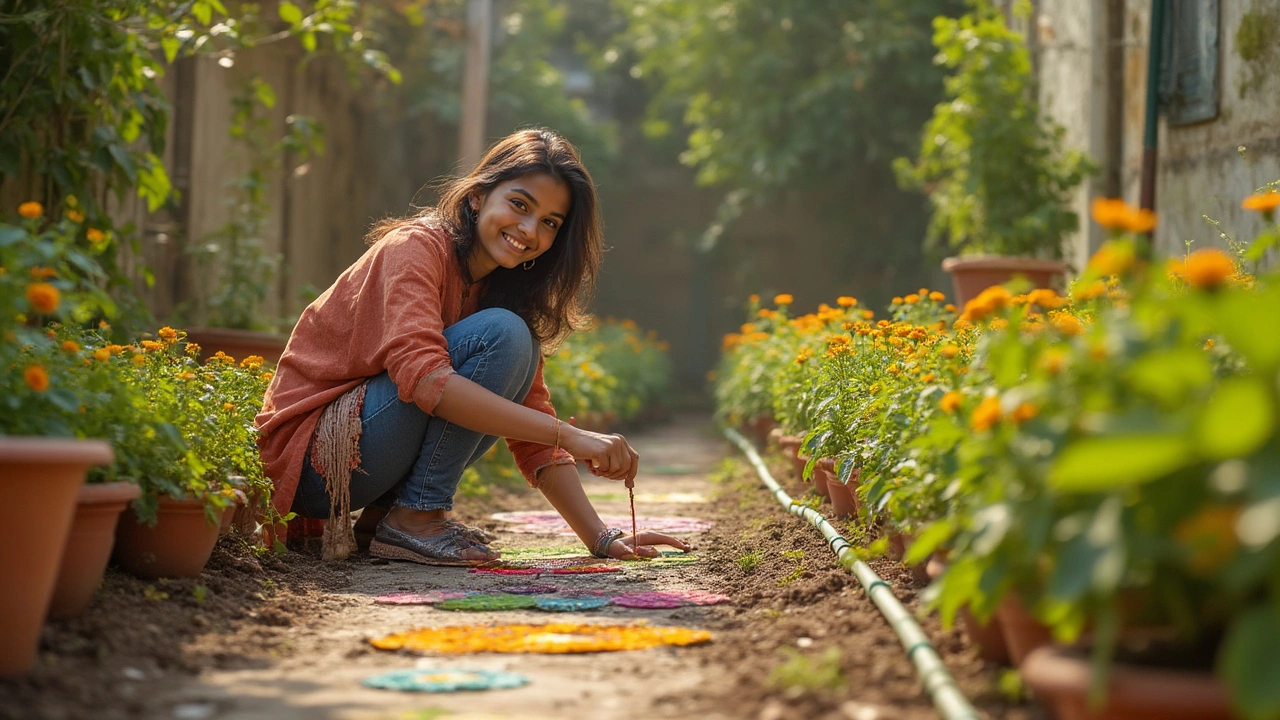Drip Irrigation System Installation: A Homeowner's Step-by-Step DIY Guide

Ever spent half your summer evenings lugging hoses around the garden, only to end up with some plants drowning and others bone-dry? You’re not alone. Gardeners everywhere are ditching the watering can for something way more efficient: drip irrigation. But the big question is—can you actually install drip irrigation yourself, or is this one of those jobs best left to the professionals? Spoiler: with a bit of patience and some smart planning, most people can absolutely handle it. Drip irrigation systems aren’t just for massive farms. Even a standard Birmingham back garden can benefit, and once it’s all set up, your plants—and your water bill—will thank you.
How Does Drip Irrigation Work and Why Bother?
Imagine watering your tomatoes from underground, whisper-quiet, with each drop going exactly where it’s needed. No soggy soil, no wasted water, no fungal freakouts from splashed leaves. That’s drip irrigation in a nutshell. Instead of dousing everything, these systems use skinny tubing dotted with small emitters (like mini taps) positioned precisely at your plants' roots. The result? Slow, steady hydration and minimal waste. A study by the Royal Horticultural Society showed that drip irrigation can cut water use by up to 60% compared to sprinklers or hosepipes. And it works whether you grow veg, flowers, or even shrubs.
Here’s a fun fact: Israel, a country not exactly famous for its rain, pioneered this technology to turn deserts green. Birmingham’s weather might be a bit less dramatic, but you’ll still save time, effort, and that guilt-trip from the next water bill. Automated timers make things even easier—imagine coming back from a week’s holiday without a single dead plant.
But why not use a standard sprinkler or watering can? Well, one issue is runoff—lots of water never even makes it into the soil, let alone to roots. Drip irrigation skips all that, meaning deeper roots and healthier plants. Plus, you’re way less likely to encourage weeds by soaking every bit of exposed earth.
So, what’s the catch? Setting it up can look intimidating with its maze of pipes and attachments. But most DIY drip kits are basically plug-and-play these days. If you can put together flat-pack furniture, you’re up for this.
What You Need Before You Start: Tools, Kits, and Planning
Before you start cutting tubing, have a clear plan—both on paper and in your head. Sketch out your garden, marking out beds, rows, and containers. Figure out which areas actually need irrigation. Not all plants are equal, and some need more water than others. For example, tomatoes and courgettes are always thirstier than your average fennel or rosemary bush.
Now, let’s break down what you’ll need:
- Drip irrigation kit (sold at garden centres or online)
- Pressure regulator (prevents burst pipes when you hook up to a mains tap)
- Filter (keeps dirt and debris out of the little emitters)
- Mainline tubing (16-13mm & 13-4mm for most gardens)
- Drippers or emitters (different flow rates for various plants)
- Punch tool (to poke holes where drippers go)
- Connectors, elbows, tees, and end plugs (for corners, splits, and capping the pipe ends)
- Timer (optional, but highly recommended for forgetful folks—like me)
- Garden stakes or clamps (to fix tubing neatly along beds)
- Sharp scissors or secateurs (to cut tubing)
Having trouble reading the tiny labels on plastic connectors? That’s normal. Just keep things organised—for bigger gardens, label different pipelines with bits of tape. If you already collect rainwater, you can use a raised barrel for pressure, but most kits in the UK are designed for a standard outdoor tap.
And because precision matters, here’s a quick table showing typical emitter rates and what they’re good for (measured in litres per hour, or LPH):
| Emitter Flow | Best For |
|---|---|
| 1.0 LPH | Soft herbs (parsley, basil), new seedlings |
| 2.0 LPH | Flower beds, small veg patches |
| 4.0 LPH | Tomatoes, squash, large shrubs |
| 8.0 LPH | Fruit trees, big containers |
If you want to go even more custom, you can buy emitters with adjustable rates, but honestly, most folks do fine with two or three fixed-flow types.
Step-by-Step: Installing Drip Irrigation in Your Garden
You’ve got your kit, your plan, and your courage. Time to actually start installing. Here’s how to do it without losing your patience.
- Lay Out the Tubing — Start by arranging the mainline tubing along your planned path, snaking it along the rows or beds. Don’t cut yet; just set things roughly in place to see how it all looks. Also, make sure it reaches your tap easily.
- Cut and Connect — Once you're happy, use scissors to trim tubing where you need bends or branches. Use T-connectors and elbows for splits and corners. Push fittings in firmly—they should be snug, but a dab of hot water makes this easier if the tubing is stiff.
- Attach the Pressure Regulator and Filter — This is where the magic starts. Attach these bits directly to your outside tap. The filter is essential in Birmingham, where old mains pipes sometimes send tiny bits of grit into your garden tap. No one wants blocked emitters a month later.
- Punch and Place Emitters — Use a punch tool or sharp object to poke holes where you want water. Insert emitters fully, making sure they’re pointing towards the plant roots. Stay a couple of inches from stems if possible, to avoid root rot.
- Secure and Stake the Tubing — Use garden stakes or clamps to keep tubing close to the soil and out of mower territory. Straight runs look neat, but don’t worry if you need a few wobbly bends—plants won’t care.
- Add the End Plug — Plug the end of your main line to avoid leaks. If you ever expand or change the system, these plugs pop out easily.
- Test and Tweak — Turn on the tap slowly, watching for leaks, drips, or pop-off connectors. See if each emitter is working. If water only dribbles out, you might need a stronger flow or to check for kinks in the tubing. It’s normal to tweak things in your first week.
- Set Up a Timer — If your budget (or memory) allows, timers let you forget about manual watering entirely. In the UK, battery-powered options do the trick and happy reviewers claim they’ve saved hours per week.
Quick tip: Always run the system for 10-15 minutes first without drippers attached to flush out any dust or plastic bits from manufacturing. Saves you headaches later.

Top Mistakes to Avoid (And How to Fix Them)
No DIY job goes perfectly the first time. But most hiccups are easy enough to fix if you know what to watch for. Here’s a list of common blunders and how to avoid them:
- Too many emitters on one line: Most home garden systems can handle about 20-25 emitters per line. If you go over, the pressure drops and some plants will suffer. Solution? Split large beds into several lines, each starting from a T-connector near the tap.
- Ignoring water pressure: Tap pressure in Birmingham can vary by estate and even time of day. Always use a pressure regulator set for 1-1.5 bar (about 15-20 psi) for drip lines. Without it, you’ll burst pipes or flood the garden unexpectedly.
- Placing emitters too close to stems: It’s tempting to poke them right at the base, but roots sprawl out. Keep them 5-10cm from the stem for better coverage as roots grow.
- Running pipes over paving or gravel: Hot summer days can make black tubing brittle if left above ground, especially on sun-blasted patios. Try to run lines under mulch or tucked next to beds where they won’t be trampled or heat up.
- Forgetting to flush the lines: Every month, remove the end plug, let water blast out, then reseal. This stops algae or dirt from building up inside the tubing.
- Winter panic: Water left inside pipes can freeze and split the tubing. In Birmingham, disconnect and drain the system by late autumn, then cover or bring delicate bits indoors. Kits with UV-resistant tubing do better at surviving the odd snowy day, too.
Don’t stress if you spot a steady drip from a connector. Nine times out of ten, it means something isn’t pushed in far enough or there’s grit in the joint. Tear it apart, clean, and try again—it’s all part of the learning curve.
Making Your Drip System Smarter and More Efficient
Once you’ve got the basics working, why not make your system a little cleverer? You’d be amazed how much tweaking you can do, even with beginner kits. Here are a few tips the pros often use, but anyone can do:
- Use a DIY irrigation timer that connects to your phone—handy if you travel or just forget things.
- Install a water sensor in the soil—these cut off water when things get too soggy, saving you money and avoiding root rot.
- Try soaker hoses in raised beds or borders. They’re like one long slow-drip emitter, and perfect for denser plantings.
- For potted plants, loop a small bit of tubing up and over each rim, anchoring with a bamboo stick. Potted plants tend to dry out faster than in the ground.
- Group thirsty and drought-tolerant plants separately—run lines to each, adjusting dripper rates as needed.
- Schedule watering before sunrise—not just to save water, but also to avoid mildew and give roots a cool morning drink.
- Mulch over exposed tubing to keep things tidy and protect against stray strimmer wires or pet claws.
- Once the kit’s established, mark where pipes are buried or hidden so you don’t dig them up later. More than one spade has found a home by splitting a hidden drip line in half!
The great thing is, every garden is unique. Maybe you’ve got a patchwork of containers, or a wild, rambling border. The best part of DIY drip irrigation is making it fit your space—add a line here, extend another there. No two installations end up quite the same.
And if you ever want to go full tech geek, smart irrigation controllers now tie in with weather forecasts. So, if rain’s coming to Birmingham on Tuesday, your system skips a beat and saves just a bit more water for the planet—and the wallet.
Is DIY Drip Irrigation Really Worth It?
After installing two different systems—one at mine, one for my sister-in-law across town—I’m convinced. You don’t need a PhD or some rare plumbing skills. The first few minutes might feel like wrangling a large, uncooperative hosepipe, but stick with it. Most people wrap up a small-to-midsize garden install in a couple of hours, maybe a full weekend for a big project with lots of containers. It’s a bit like grown-up Lego, but with more mud and a much bigger pay-off.
Here’s the honest bit: it isn’t 100% ‘set and forget’. Emitters can clog, tubing might work itself loose after a rough football match, and you’ll need to check for winter freeze. But the time savings are massive compared to hand watering (I’d say a typical Birmingham allotment keeper saves at least five hours per week in midsummer). Plus, you’ll probably see happier, more productive plants—especially with unpredictable British weather.
One final stat: according to Thames Water, a single hour of hand watering with a hosepipe can use up to 540 litres of water. With a drip system, the same plot could thrive on less than 120 litres, even at the height of a heatwave.
So, can you install drip irrigation yourself? If you’ve read this far, you’re more than ready. Trust me—the only regret you’ll have is not starting sooner. And just wait for that first rainy evening when you’re tucked up by the telly, not traipsing down the muddy garden path with a leaky watering can. The plants will love it. You’ll love it. Your back will definitely love it.





